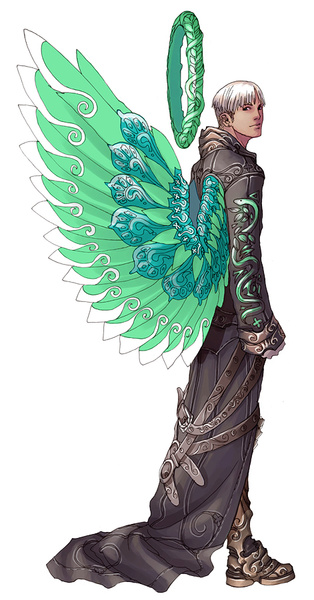Name: Raphael
Sex: Male
Species: Archangel
Height: 6ft 2in
Weight: 280 lbs
Age: Unknown
Age in appearance: 27
Hair Color: White
Eye Color: Brown
Skin Color: Peachy
Personality: Kind and caring
Weakness: Darkness
Profession: Healer of the angels
Weapons: Scalpels and daggers, heavenly sword
Armor: Black trenchcoat filled with heavenly magic
Items: A small notebook with heavenly script on it, various small vials of liquid
Skills: Healing magic, purification
Picture:


Stats:
Fighting: Excellent
Agility: Remarkable
Strength: Typical, Borderline Good
Endurance: Remarkable
Reasoning: Remarkable
Intuition: Incredible
Psyche: Incredible
Biography:
Raphael (Standard Hebrew ???????, Rafa?el, "It is God who heals", "God Heals", "God, Please Heal") is an archangel of Judaism and Christianity, who in the Judeo-Christian tradition performs all manners of healing. In Islam, Raphael is the same as Israfel.
Raphael in Judaism
The angels mentioned in the Torah, the older books of the Hebrew Bible, are without names. Rabbi Shimon ben Lakish of Tiberias (A.D. 230–270), asserted that all the specific names for the angels were brought back by the Jews from Babylon, and modern commentators would tend to agree. Raphael is named in several Jewish apocryphal books.
Raphael in the Book of Enoch
Raphael bound Azazel under a desert called Dudael according to Enoch 10:4–6:
And again the Lord said to Raphael: 'Bind Azazel hand and foot, and cast him into the darkness: and make an opening in the desert, which is in Dudael, and cast him therein. And place upon him rough and jagged rocks, and cover him with darkness, and let him abide there for ever, and cover his face that he may not see light. And on the day of the great judgment he shall be cast into the fire.
Of seven archangels in the angelology of post-Exilic Judaism, only Michael, mentioned as archangel (Daniel 12:1)(Jude verse 9) and Gabriel are mentioned by name in the scriptures that came to be accepted as canonical by all Christians. Raphael is mentioned by name in the Book of Tobit, which is accepted as canonical by Catholics, Anglicans and Orthodox. The root of the name Raphael also appears in the modern Hebrew word Rophe meaning doctor of medicine, thus echoing the healing function traditionally attributed to this angel.
Raphael in Catholicism
The name of the angel Raphael appears only in the Deuterocanonical Book of Tobit. The Book of Tobit is considered canonical by Roman Catholic, Anglican and Orthodox Christians. Raphael first appears disguised in human form as the travelling companion of Tobit's son, Tobiah (Greek: ??ß?a?/Tobias), calling himself "Azarias the son of the great Ananias". During the adventurous course of the journey the archangel's protective influence is shown in many ways including the binding of the demon in the desert of upper Egypt. After the return and the healing of the blindness of Tobit, Azarias makes himself known as "the angel Raphael, one of the seven, who stand before the Lord" Tobit 12:15. Compare the unnamed angels in John's Revelation 8:2. He is often venerated and patronized as Saint Raphael the Archangel.
Regarding the healing powers attributed to Raphael, we have his declaration to Tobit (Tobit, 12) that he was sent by the Lord to heal him of his blindness and to deliver Sarah, his future daughter-in-law, from the demon Asmodeus, who abducts and kills every man she marries on their wedding night before the marriage can be consummated. Among Catholics, he is considered the patron saint of medical workers, matchmakers, and travellers and may be petitioned by them or those needing their services.
The feast day of Raphael was included for the first time in the General Roman Calendar in the year 1921, for celebration on October 24. With the reform of the Roman Catholic Calendar of Saints in 1969, this feast was transferred to September 29 for celebration together with Saint Michael and Saint Gabriel. Within limits, the Roman Catholic Church still authorizes use of the 1962 calendar. The Church of England also celebrates "Michael and All Angels" on September 29.
Raphael has made an impression on Catholic geography: Saint Raphaël, France and Saint Raphaël, Quebec, Canada; San Rafaels in Argentina, Bolivia, Colombia, Costa Rica, Chile, Mexico, Trinidad and Tobago, Peru, the Philippines and in Venezuela as San Rafael de Mohán and San Rafael de Orituco. In the United States, San Rafaels inherited from Mexico survive in California (where besides the city there are San Rafael Mountains), in New Mexico, and in Utah, where the San Rafael River flows seasonally in the San Rafael Desert. The Archangel also lends his name to St. Raphael's Cathedral, the seat of the Diocese of Madison, Wisconsin, to St. Raphael's Cathedral, the seat of the Archdiocese of Dubuque, and to Mission San Rafael Arcángel in San Rafael, California.
In the New Testament, only the archangels Gabriel and Michael are mentioned by name (Luke 1:9-26; Jude 1:9). Later manuscripts of John 5:1-4 refer to the pool at Bethesda, where the multitude of the infirm lay awaiting the moving of the water, for "an angel of the Lord descended at certain times into the pond; and the water was moved. And he that went down first into the pond after the motion of the water was made whole of whatsoever infirmity he lay under". Because of the healing role assigned to Raphael, this particular angel is generally associated with the archangel. Raphael is sometimes shown as standing atop a large fish or holding a caught fish at the end of a line. This is a reference to Book of Tobit (Tobias), where he told Tobias to catch a fish, and then uses the gallbladder to heal Tobit's eyes, and to drive away Asmodeus by burning the heart and liver.
Raphael in Islam
Raphael is honored in Islam as one of the great archangels. He is Israfel in Islam. According to the hadith, He is the angel responsible for signaling the coming of Judgment Day by blowing the trumpet (namely Sûr). According to tradition, the trumpet will be blown two times. The first blow of the trumpet will signal the beginning of Last Day and the second blow will signal the time when all the souls will be gathered for the Last Judgement. He is known more commonly as "Israfel" in Islamic history. According to the Quran, he has been holding his breath, waiting for Allah's order to blow the Sûr.
Paradise Lost
The angel Raphael, along with many other prominent angels, appears in John Milton's Paradise Lost, in which he is assigned by God to re-warn Adam concerning the sin of eating of the Tree of the knowledge of good and evil. He also expounds to Adam the War in Heaven in which Lucifer and the demons fell, and the creation of the Earth.
